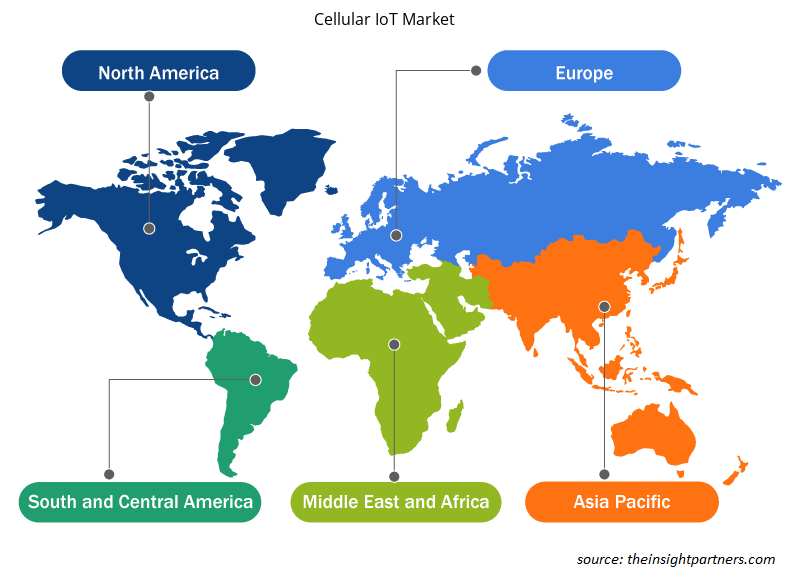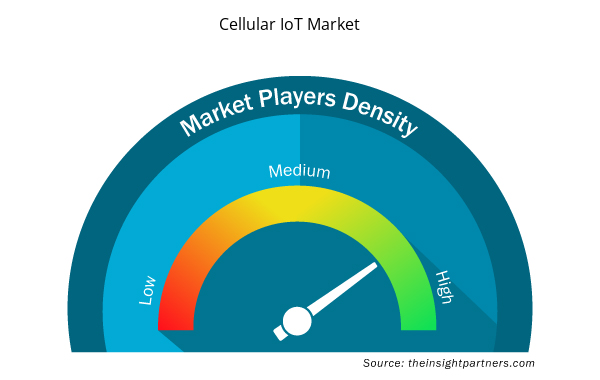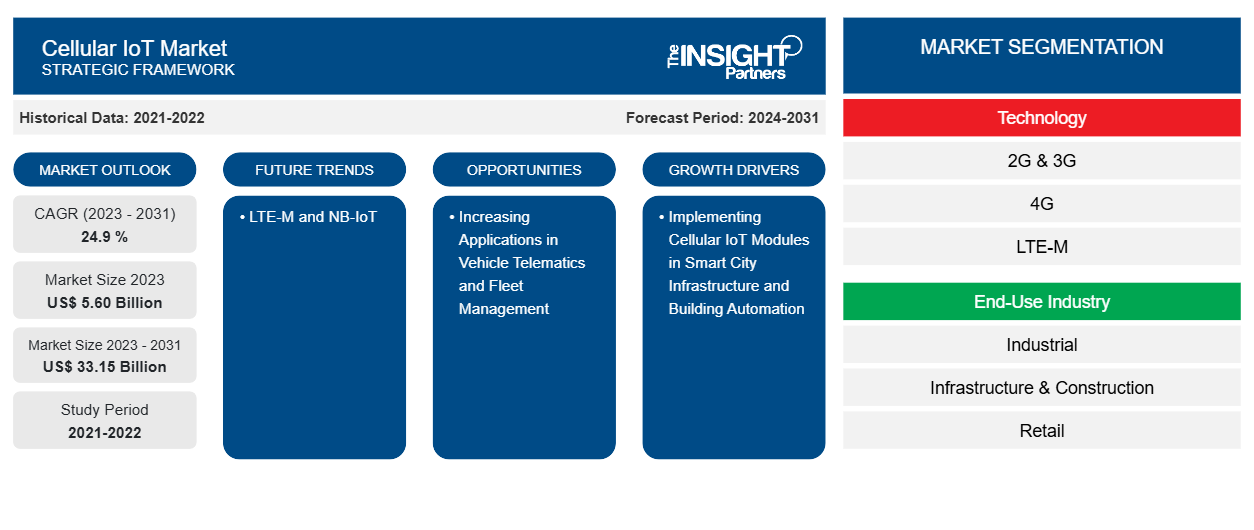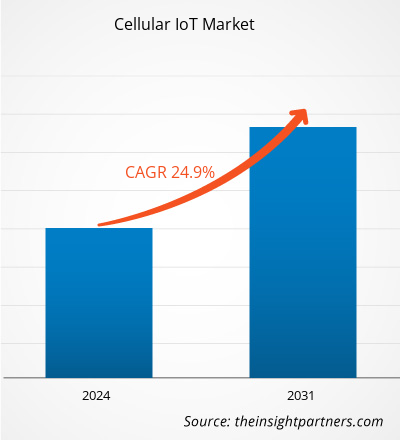Der Markt für zellulares IoT soll von 5,60 Milliarden US-Dollar im Jahr 2023 auf 33,15 Milliarden US-Dollar im Jahr 2031 anwachsen. Der Markt für zellulares IoT soll in den Jahren 2023–2031 eine durchschnittliche jährliche Wachstumsrate von 24,9 % verzeichnen. Zellulare IoT-Module werden zunehmend in der Smart-City-Infrastruktur und Gebäudeautomatisierung sowie in der Agrarautomatisierung und Umweltüberwachung eingesetzt und treiben so das Marktwachstum voran.
Marktanalyse für zellulares IoT
Cellular IoT kann die sehr sensiblen und einzigartigen Anforderungen komplizierter Anwendungen und Einstellungen sowie die grundlegenderen Anforderungen des riesigen IoT-Marktes erfüllen. Es gibt zwei Haupttypen von Cellular IoT: Long Term Evolution for Machines (LTE-M) und Narrowband Internet of Things (NB-IoT). Beispiele für NB-IoT- und LTE-M-Anwendungen sind Präzisionslandwirtschaft, Smart Cities, Verkaufsautomaten, Flottenüberwachung und andere, die alle erhebliche Aussichten auf Marktanteile im Bereich Cellular IoT bieten. Diese Anwendungen erfordern eine zuverlässige und sichere Fernkommunikation.
Marktübersicht für zellulares IoT
Die Präsenz schnell wachsender Länder, die zunehmende Akzeptanz fortschrittlicher Technologien und eine wachsende Zahl vernetzter Geräte gehören zu den Hauptgründen, die die globale Expansion des zellularen IoT vorantreiben sollen. Der globale zellulare IoT-Markt wird voraussichtlich aufgrund der zunehmenden Digitalisierung und Automatisierung in Branchen wie der Automobilindustrie, der Fertigung sowie der Energie- und Versorgungswirtschaft wachsen. Die zunehmende Nachfrage nach erweiterter Netzabdeckung, die verbesserte Neigung zur Geschäftsentwicklung über mobiles Breitband hinaus und die Notwendigkeit, eine große Anzahl vernetzter Geräte in Unternehmen weltweit unterzubringen, werden voraussichtlich die Größe des zellularen IoT-Marktes vorantreiben.
Passen Sie diesen Bericht Ihren Anforderungen an
Sie erhalten kostenlos individuelle Anpassungen an jedem Bericht, einschließlich Teilen dieses Berichts oder einer Analyse auf Länderebene, eines Excel-Datenpakets sowie tolle Angebote und Rabatte für Start-ups und Universitäten.
- Holen Sie sich die wichtigsten Markttrends aus diesem Bericht.Dieses KOSTENLOSE Beispiel umfasst eine Datenanalyse von Markttrends bis hin zu Schätzungen und Prognosen.
Treiber und Chancen des Mobilfunk-IoT-Marktes
Implementierung zellularer IoT-Module in Smart-City-Infrastrukturen und Gebäudeautomatisierung zur Förderung des Marktes
Smart City Building und Infrastrukturautomatisierung sind die beiden wichtigsten vertikalen Einsatzbereiche für zellulare IoT-Module und machen den Großteil des Umsatzes des zellularen IoT-Marktes aus. Dank neuer zellularer IoT-Technologien wie NB-LTE-M, NB-IoT und 5G können batteriebetriebene Geräte jetzt eine Verbindung zum Internet herstellen. Diese Technologien verbinden Geräte effektiver als aktuelle 2G- und 3G-Technologien, darunter intelligentes Parken und intelligente Straßenbeleuchtung. Straßenlaternen, Verkehrssensor- und -kontrollgeräte, Müllentsorgungsgeräte und Parkraummanagementgeräte sind nur einige der vielen Einsatzmöglichkeiten für zellulares IoT in Smart Cities. Moderne Infrastrukturverbesserungen haben für Regierungen auf der ganzen Welt höchste Priorität, und um dieses Ziel zu erreichen, werden mehrere Pilotprojekte gestartet.
Zunehmende Anwendungen in Fahrzeugtelematik und Flottenmanagement
Fahrzeugtelematik ist eine der wichtigsten neuen Anwendungen für zellulares IoT, da sie Leistung und Verbindung verbessert und gleichzeitig die Ressourcen eines Unternehmens nutzt. Der Trend, Telematiksysteme in Gelände- und Straßenfahrzeugen einzusetzen, dürfte erhebliches Entwicklungspotenzial generieren. Bei Geländegeräten wie Kränen und Baggern mit einer begrenzten Anzahl an Fachkräften ist Zeit ein kritischer Faktor. Die Implementierung von IoT- und Telematiklösungen ist für die Überwachung von Geräten und Straßengütern erforderlich. Daher integrieren Anbieter von Telematiklösungen zellulare IoT-Module in ihre Produktangebote, wodurch Flottenmanager und OEMs von Geländefahrzeugen Felddaten, Trends und Probleme leichter erfassen und analysieren können.
Segmentierungsanalyse des Cellular IoT-Marktberichts
Wichtige Segmente, die zur Ableitung der Marktanalyse für zellulares IoT beigetragen haben, sind Technologie, Bereitstellung, Endverbrauchsbranche und Endbenutzer.
- Basierend auf der Technologie ist der zellulare IoT-Markt in 2G & 3G, 4G, LTE-M, NB-IoT und 5G segmentiert.
- Basierend auf der Endverbrauchsbranche ist der zellulare IoT-Markt in die Bereiche Industrie, Infrastruktur und Bau, Einzelhandel, Unterhaltungselektronik , Automobil und Transport, Energie und Versorgung, Gesundheitswesen und Sonstige segmentiert.
Cellular IoT Marktanteilsanalyse nach Geografie
Der geografische Umfang des Marktberichts zum zellularen IoT ist hauptsächlich in fünf Regionen unterteilt: Nordamerika, Asien-Pazifik, Europa, Naher Osten und Afrika sowie Südamerika/Süd- und Mittelamerika. Länder wie Indien und China haben eine große Anzahl von Halbleiterhändlern. Darüber hinaus wird erwartet, dass der wachsende Markteintritt von Technologieunternehmen in der Region sowie erhöhte Investitionen in IoT-Technologien die Marktexpansion vorantreiben werden. Regierungen in asiatischen Ländern wie Indien sind ebenfalls an der zellularen IoT-Branche interessiert und setzen eine Reihe intelligenter Infrastrukturprojekte um. Die Regierungen von Indien, Japan, China, Korea, Malaysia und Singapur haben sich für nationale zellulare IoT-Richtlinien ausgesprochen.
Regionale Einblicke in den Mobilfunk-IoT-Markt
Die regionalen Trends und Faktoren, die den Markt für zellulares IoT im Prognosezeitraum beeinflussen, wurden von den Analysten von Insight Partners ausführlich erläutert. In diesem Abschnitt werden auch die Marktsegmente und die Geografie für zellulares IoT in Nordamerika, Europa, im asiatisch-pazifischen Raum, im Nahen Osten und Afrika sowie in Süd- und Mittelamerika erörtert.

- Erhalten Sie regionale Daten zum Mobilfunk-IoT-Markt
Umfang des Marktberichts für zellulares IoT
| Berichtsattribut | Details |
|---|---|
| Marktgröße im Jahr 2023 | 5,60 Milliarden US-Dollar |
| Marktgröße bis 2031 | 33,15 Milliarden US-Dollar |
| Globale CAGR (2023 - 2031) | 24,9 % |
| Historische Daten | 2021-2022 |
| Prognosezeitraum | 2024–2031 |
| Abgedeckte Segmente | Nach Technologie
|
| Abgedeckte Regionen und Länder | Nordamerika
|
| Marktführer und wichtige Unternehmensprofile |
|
Dichte der Akteure auf dem Mobilfunk-IoT-Markt: Auswirkungen auf die Geschäftsdynamik verstehen
Der Markt für zellulares IoT wächst rasant, angetrieben durch die steigende Nachfrage der Endnutzer aufgrund von Faktoren wie sich entwickelnden Verbraucherpräferenzen, technologischen Fortschritten und einem größeren Bewusstsein für die Vorteile des Produkts. Mit steigender Nachfrage erweitern Unternehmen ihr Angebot, entwickeln Innovationen, um die Bedürfnisse der Verbraucher zu erfüllen, und nutzen neue Trends, was das Marktwachstum weiter ankurbelt.
Die Marktteilnehmerdichte bezieht sich auf die Verteilung der Firmen oder Unternehmen, die in einem bestimmten Markt oder einer bestimmten Branche tätig sind. Sie gibt an, wie viele Wettbewerber (Marktteilnehmer) in einem bestimmten Marktraum im Verhältnis zu seiner Größe oder seinem gesamten Marktwert präsent sind.
Die wichtigsten auf dem Cellular-IoT-Markt tätigen Unternehmen sind:
- Arm Holdings Plc
- AT&T, Inc.
- Ericsson
- Huawei Technologies Co., Ltd.
- Mediatek Inc.
- Qualcomm Incorporated
Haftungsausschluss : Die oben aufgeführten Unternehmen sind nicht in einer bestimmten Reihenfolge aufgeführt.

- Überblick über die wichtigsten Akteure auf dem Cellular-IoT-Markt
Neuigkeiten und aktuelle Entwicklungen zum Mobilfunk-IoT-Markt
Der Markt für zellulares IoT wird durch die Erhebung qualitativer und quantitativer Daten nach Primär- und Sekundärforschung bewertet, die wichtige Unternehmensveröffentlichungen, Verbandsdaten und Datenbanken umfasst. Im Folgenden finden Sie eine Liste der Entwicklungen auf dem Markt:
- Im Mai 2022 gab Audi ein Update zu seiner Zusammenarbeit mit der Mobilitätsplattform Spoke und anderen Partnern bekannt, um mithilfe der Cellular Vehicle-to-Everything (C-V2X)-Technologie Unfälle mit Fahrrädern und Autos zu minimieren. Darüber hinaus arbeitete Audi mit C-V2X zusammen, das LTE-Mobilfunksignale und direkte PC5-Signale verwendet, die kein Mobilfunknetz benötigen, um einen Radfahrer zu erkennen.
(Quelle: Audi, Pressemitteilung, 2022)
- Im Januar 2023 kündigte Sierra Wireless die Einführung von Smart Connectivity Premium in den USA an, das eUICC-Funktionen und eine erweiterte Konnektivitätsabdeckung umfasst. Darüber hinaus bietet Smart Connection Premium mit seinem Multi-IMSI- und Multi-Profile-Design, das durch die GSMA eSIM (eUICC)-Anforderungen unterstützt wird, eine robuste, IoT-verwaltete Verbindung, die über Länder und Technologien hinweg mit einer einzigen globalen SIM zukunftssicher ist.
(Quelle: Sierra Wireless, Pressemitteilung, 2023)
Marktbericht zum zellularen IoT: Abdeckung und Ergebnisse
Der Bericht „Cellular IoT Market Size and Forecast (2021–2031)“ bietet eine detaillierte Analyse des Marktes, die die folgenden Bereiche abdeckt:
- Marktgröße und Prognose auf globaler, regionaler und Länderebene für alle wichtigen Marktsegmente, die im Rahmen des Projekts abgedeckt sind
- Marktdynamik wie Treiber, Beschränkungen und wichtige Chancen
- Wichtige Zukunftstrends
- Detaillierte PEST/Porters Five Forces- und SWOT-Analyse
- Globale und regionale Marktanalyse mit wichtigen Markttrends, wichtigen Akteuren, Vorschriften und aktuellen Marktentwicklungen
- Branchenlandschaft und Wettbewerbsanalyse, einschließlich Marktkonzentration, Heatmap-Analyse, prominenten Akteuren und aktuellen Entwicklungen
- Detaillierte Firmenprofile
- Historische Analyse (2 Jahre), Basisjahr, Prognose (7 Jahre) mit CAGR
- PEST- und SWOT-Analyse
- Marktgröße Wert/Volumen – Global, Regional, Land
- Branche und Wettbewerbsumfeld
- Excel-Datensatz



Report Coverage
Revenue forecast, Company Analysis, Industry landscape, Growth factors, and Trends

Segment Covered
This text is related
to segments covered.

Regional Scope
North America, Europe, Asia Pacific, Middle East & Africa, South & Central America

Country Scope
This text is related
to country scope.
Häufig gestellte Fragen
The global cellular IoT market was estimated to be US$ 5.60 billion in 2023 and is expected to grow at a CAGR of 24.9 % during the forecast period 2023 - 2031.
Implementing cellular IoT modules in smart city infrastructure and building automation are the major factors that propel the global cellular IoT market.
LTE-M and NB-IoT are anticipated to play a significant role in the global cellular IoT market in the coming years.
The key players holding majority shares in the global cellular IoT market are Arm Holdings Plc., AT&T, Inc., Ericsson, Huawei Technologies Co., Ltd., and Mediatek Inc.
The global cellular IoT market is expected to reach US$ 33.15 billion by 2031.
Trends and growth analysis reports related to Technology, Media and Telecommunications : READ MORE..
The Insight Partners performs research in 4 major stages: Data Collection & Secondary Research, Primary Research, Data Analysis and Data Triangulation & Final Review.
- Data Collection and Secondary Research:
As a market research and consulting firm operating from a decade, we have published and advised several client across the globe. First step for any study will start with an assessment of currently available data and insights from existing reports. Further, historical and current market information is collected from Investor Presentations, Annual Reports, SEC Filings, etc., and other information related to company’s performance and market positioning are gathered from Paid Databases (Factiva, Hoovers, and Reuters) and various other publications available in public domain.
Several associations trade associates, technical forums, institutes, societies and organization are accessed to gain technical as well as market related insights through their publications such as research papers, blogs and press releases related to the studies are referred to get cues about the market. Further, white papers, journals, magazines, and other news articles published in last 3 years are scrutinized and analyzed to understand the current market trends.
- Primary Research:
The primarily interview analysis comprise of data obtained from industry participants interview and answers to survey questions gathered by in-house primary team.
For primary research, interviews are conducted with industry experts/CEOs/Marketing Managers/VPs/Subject Matter Experts from both demand and supply side to get a 360-degree view of the market. The primary team conducts several interviews based on the complexity of the markets to understand the various market trends and dynamics which makes research more credible and precise.
A typical research interview fulfils the following functions:
- Provides first-hand information on the market size, market trends, growth trends, competitive landscape, and outlook
- Validates and strengthens in-house secondary research findings
- Develops the analysis team’s expertise and market understanding
Primary research involves email interactions and telephone interviews for each market, category, segment, and sub-segment across geographies. The participants who typically take part in such a process include, but are not limited to:
- Industry participants: VPs, business development managers, market intelligence managers and national sales managers
- Outside experts: Valuation experts, research analysts and key opinion leaders specializing in the electronics and semiconductor industry.
Below is the breakup of our primary respondents by company, designation, and region:

Once we receive the confirmation from primary research sources or primary respondents, we finalize the base year market estimation and forecast the data as per the macroeconomic and microeconomic factors assessed during data collection.
- Data Analysis:
Once data is validated through both secondary as well as primary respondents, we finalize the market estimations by hypothesis formulation and factor analysis at regional and country level.
- Macro-Economic Factor Analysis:
We analyse macroeconomic indicators such the gross domestic product (GDP), increase in the demand for goods and services across industries, technological advancement, regional economic growth, governmental policies, the influence of COVID-19, PEST analysis, and other aspects. This analysis aids in setting benchmarks for various nations/regions and approximating market splits. Additionally, the general trend of the aforementioned components aid in determining the market's development possibilities.
- Country Level Data:
Various factors that are especially aligned to the country are taken into account to determine the market size for a certain area and country, including the presence of vendors, such as headquarters and offices, the country's GDP, demand patterns, and industry growth. To comprehend the market dynamics for the nation, a number of growth variables, inhibitors, application areas, and current market trends are researched. The aforementioned elements aid in determining the country's overall market's growth potential.
- Company Profile:
The “Table of Contents” is formulated by listing and analyzing more than 25 - 30 companies operating in the market ecosystem across geographies. However, we profile only 10 companies as a standard practice in our syndicate reports. These 10 companies comprise leading, emerging, and regional players. Nonetheless, our analysis is not restricted to the 10 listed companies, we also analyze other companies present in the market to develop a holistic view and understand the prevailing trends. The “Company Profiles” section in the report covers key facts, business description, products & services, financial information, SWOT analysis, and key developments. The financial information presented is extracted from the annual reports and official documents of the publicly listed companies. Upon collecting the information for the sections of respective companies, we verify them via various primary sources and then compile the data in respective company profiles. The company level information helps us in deriving the base number as well as in forecasting the market size.
- Developing Base Number:
Aggregation of sales statistics (2020-2022) and macro-economic factor, and other secondary and primary research insights are utilized to arrive at base number and related market shares for 2022. The data gaps are identified in this step and relevant market data is analyzed, collected from paid primary interviews or databases. On finalizing the base year market size, forecasts are developed on the basis of macro-economic, industry and market growth factors and company level analysis.
- Data Triangulation and Final Review:
The market findings and base year market size calculations are validated from supply as well as demand side. Demand side validations are based on macro-economic factor analysis and benchmarks for respective regions and countries. In case of supply side validations, revenues of major companies are estimated (in case not available) based on industry benchmark, approximate number of employees, product portfolio, and primary interviews revenues are gathered. Further revenue from target product/service segment is assessed to avoid overshooting of market statistics. In case of heavy deviations between supply and demand side values, all thes steps are repeated to achieve synchronization.
We follow an iterative model, wherein we share our research findings with Subject Matter Experts (SME’s) and Key Opinion Leaders (KOLs) until consensus view of the market is not formulated – this model negates any drastic deviation in the opinions of experts. Only validated and universally acceptable research findings are quoted in our reports.
We have important check points that we use to validate our research findings – which we call – data triangulation, where we validate the information, we generate from secondary sources with primary interviews and then we re-validate with our internal data bases and Subject matter experts. This comprehensive model enables us to deliver high quality, reliable data in shortest possible time.


 Holen Sie sich ein kostenloses Muster für diesen Bericht
Holen Sie sich ein kostenloses Muster für diesen Bericht